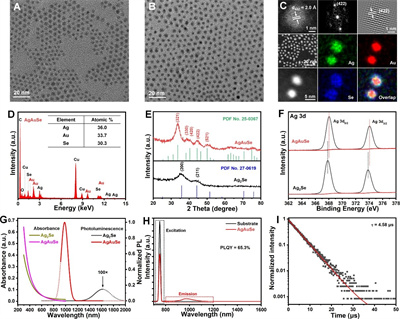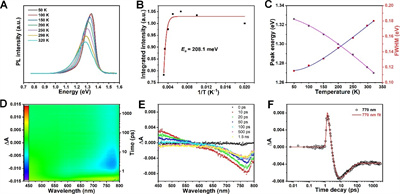Colloid inorganic semiconductor quantum dots (QDs) possess numerous unique properties in physics and chemistry including size-tunable fluorescence emission, high photoluminescence (PL) brightness, facile surface functionalization, and photochemical/physical stability. Based on these advantageous properties, QDs have been widely applied in various fields from photonics to biotechnology, such as light emitting diodes (LEDs), solar cells, lasers and biomedical imaging. Therefore, the design and synthesis of QDs with high photoluminescence quantum yield (PLQY), tunable emission, and excellent biocompatibility has been a lasting hot research topic, which helps to achieve optimum performance of device efficiency and in vivo imaging.
QDs with PL emission at 900-1700 nm (denoted as the second near-infrared window, NIR-II) exhibit much-depressed photon absorption and scattering, which has been popular in biomedical imaging and NIR LED. Ag based QDs (Ag2S and Ag2Se) are one of typical NIR-II nanoprobes without containing toxicity of heavy metal elements like Cd, Hg, and Pb. So far, Ag2S and Ag2Se QDs have been widely used in many applications due to their environmentally benign properties considering their low solubility and non-toxic heavy metal elements.
Taking Ag2Se as an example, it has narrow direct band gap of 0.15 eV for bulk materials, and shows great PL properties in NIR-II window, being a promising alternative as whole NIR-II emitting nanoprobes. However, in comparison with visible-emission QDs, many of which can be up to near-unity PLQY, the NIR-II QDs often exhibit poor fluorescence intensity. In the case of Ag2Se, the high mobility of Ag ion gives rise to abundant cation vacancies and crystal defects, leading to a low absolute PLQY below 1%. Therefore, developing a new strategy to gain Ag based QDs with high PLQY is of great significance.
Recently, Prof. Qiangbin Wang (Suzhou Institute of Nano-Tech and Nano-Bionics, CAS) cooperated with Prof. Xueyuan Chen (Fujian Institute of Material Structure, CAS), for the first time, reported an alloying strategy to synthesize silver gold selenide (AgAuSe) QDs with a record absolute PLQY of 65.3% at 978 nm. The QDs also present a narrow FWHM of 90 nm and long lifetime of 4.58 μs. Moreover, the PL emission peak of the alloyed AgAuSe QDs can be tuned from 820 to 1170 nm. These high-PLQY QDs with non-toxic heavy metal exhibited great potential in bioimaging, LEDs and photovoltaic devices.
This work entitled "Colloidal Alloyed Quantum Dots with Enhanced Photoluminescence Quantum Yield in the NIR-II Window" was recently published in Journal of the American Chemical Society.
This work was financially supported by the National Key Research and Development Program, the National Natural Science Foundation of China, the Strategic Priority Research Program of Chinese Academy of Sciences.

Figure 1. Characterization of Ag2Se and AgAuSe QDs.

Figure 2. Temperature-dependent PL spectra and femtosecond transient absorption of the alloyed AgAuSe QDs.
Contact information: Prof. Qiangbin, Wang, Suzhou Institute of Nano-Tech and Nano-Bionics, Chinese Academy of Sciences
Email: qbwang2008@sinano.ac.cn
Reference: https://doi.org/10.1021/jacs.0c13071

